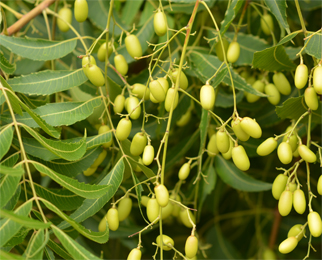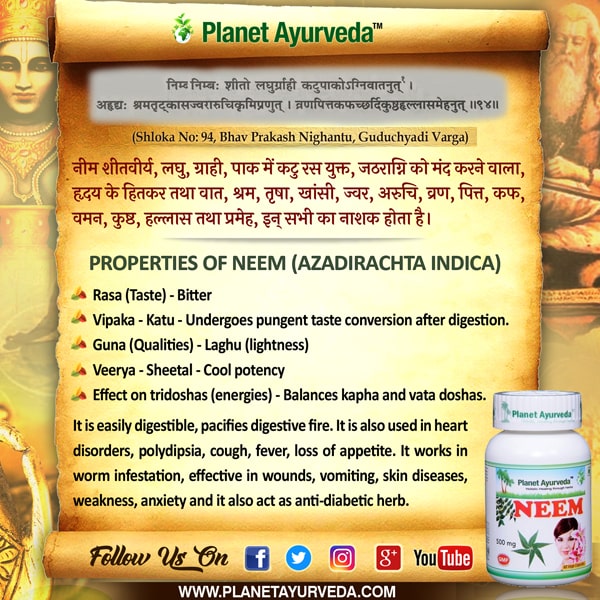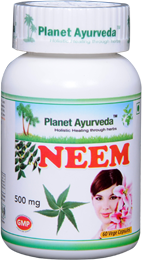Neem, Indian Lilac (Azadirachta indica) – Properties, Benefits & Dosage

Description of Plant
Neem is evergreen tree but in extreme drought conditions this tree may shed almost all its leaves. It is fastest growing tree that reaches height up to 15-20mt and old trees may reach height up to 35-40mts. Branches of this tree are long, wide and spreading and has dense roundish crown. Diameter of the crown of old trees is about 15-20mts. This tree resembles very much to like tree of chinaberry. Trunk of the tree is short and straight about 1-2mt in diameter. Simple and opposite leaves are about 3-8cm long; young leaves of the plant are reddish to purple in color and mature leaves are dark green in color. Auxiliary flowers are arranged in drooping panicles and are small, white colored and fragrant. Size of individual flower is about 5-6mm long and 8-11mm wide. Olive like drupe fruit is oval to round in shape, smooth and immature fruits are green in color. After ripening color of fruit changes to yellow with pulp and seed inside.
General Description
In Ayurveda whole plant is used for its medicinal uses. Leaves and bark is used as blood purifier and are best to use for various skin troubles. Fruits of the plant are good carminative, purgative and emollient. Flowers are very good tonic and used for treating stomach disorders. Sanskrit name used for this herb is arishta that means perfect, complete and imperishable. Nature has served this plant with various organic compounds that are used as insecticides and pesticides. Wood of this plant is very hard and resistant to termite, bacteria, parasites and fungi. Commercially this wood is used for making doors, carts, yokes, packing boxes, ceiling blocks, furniture and also used in ships and boats. Bark is bitter, astringent and tonic used for the treatment of fever, nausea, vomiting and skin aliments.
Neem seed pulp is used in the production of methane gas in methane gas plant. Neem bark is rich in tannins and due to these tannins it is used for tanning and dyes.
Various chemical compounds available in this plant are nimbin, nimbinene, azadirachtol, azadirachtin, azadirachnol, nimbadinol, nimbolide, beta-sistosterol, quceretine, nimbiol, nimcine and n-hexacosanol.
Classification
- Kingdom – Plantae
- Order – Rutales
- Family – Meliaceae
Habitat
This herb is native to India and found in tropical and sub-tropical regions of India, Myanmar, Bangladesh, Sri Lanka and Pakistan. In India it is available in open grasslands, woodlands, food plains and costal sites.
Names
- Latin name – Azadirachta indica
- Common name – Neem, Nimtree, Indian lilac
- Sanskrit name – Arishta, Pakvakrita, Nimbaka
- Assamese name – Neem
- Hindi name – Neem
- Kannada name – Bevu
- Malayalam name – Aryaveppu
- Tamil name – Veppai, Sengumaru
- Telugu name – Vepa
- Marathi name – Kandunimba
- Manipuri name – Neem
- Gujarati name – Dhanujhada, Limbda
- Sinhala name – Kohomba
- French name – Azadriac le l’llnde, Margosier, Margousier
- German name – Indischer zedrach
- Nepalese name – Neem
- Myanmar name – Tamar
- Punjabi name – Nihmm
- Sindhi name – Nimm
- Thai name – Sadao
- Urdu name – Neem
- Portuguese name – Nimbo, Margosa
- Persian name – Nib, Neemb
Watch Videos on Neem Herb by Dr. Vikram Chauhan (MD Ayurveda)
Ayurvedic properties
| Hindi / Sanskrit | English | ||
| Rasa | Bitter, Astringent | Taste | Tikta, Kashaya |
| Guna | Laghu, Rooksha | Physical Property | Light, Dry |
| Virya | Sheet | Potency | Cold |
| Vipaka | Katu | Metabolic Property (After Digestion) | Pungent |
Effects on Doshas
It balances pitta and Kapha doshas.
| Charak Samhita | Sushrut Samhita |
|
|
Ancient verse about Azadirachta Indica


The Bhavprakash nighantu Twenty Eighth edition of 2010: verse 13-16, page no-314.
- First shalok states that nimb, pichoomard, tikatak, arishta, paribhadra and hinguniryas are various synonyms of Azadirachta indica. Neem is light, absorbent, and pungent after digestion and has cold potency. It is used to control digestive fire and this herb is not good for heart. Neem is used in the treatment of vata disorders, thirst, cough, fever, anorexia, worms, wounds, pitta and kapha dosha and it is also used in the treatment of nausea, vomiting, leprosy and diabetes.
- Second verse states that leaves of neem are good for eyes, used for treating kapha, pitta dosha and poisoning, aggravates vata dosha, and very beneficial for all types of anorexia and leprosy. Leaves are bitter in taste and are pungent after digestion. Leaves are carminative, unctuous, light, hot in potency and used for various disorders like leprosy, tumors, piles, worms and diabetes.
References
The Bhavprakash nighantu with elaborated Hindi commentary by Padmashri prof. K.C. Chunekar, edited by Late Dr. G.S. Pandey: Twenty Eighth edition of 2010: gudchayadi varga; verse 13-16, page no-314.
Practical Uses of Azadirachta Indica
- Neem is major herb with anti-fungal, anti-bacterial, anti-diabetic, sedative, anti-viral and anti-helminthic properties.
- This herb is best used to prepare various medicinal shampoos, soaps, creams and balms for the smoothing of skin and to protect skin from various troubles like pimples, acne, wounds and ulcers.
- In old medicine system it was saying that sufferers of chicken pox should sleep on neem leaves to cure the disease.
- All the parts of this plant are used for preparing various medicinal formulations for treating numerous body disorders.
- Neem paste is applied externally to cure pimples and acne and decoction of neem leaves are used as blood purifier and to clear all impurities and toxins from blood stream.
- Parts of neem tree are used to prepare various supplements and medicines for the diabetic patients.
- Twigs of the neem tree are used for cleansing teeth and used for treating various aliments associated with mouth and teeth disorders like gum swelling and bleeding gums.
- Decoction of neem roots are used to cure fever. Neem leaf extract is used in the treatment of malaria.
- This herb is used to neutralize various types of pests, insects, mites and ticks.
- Neem is an herb that is used to treat vitiated pitta and various pitta disorders such as leprosy, skin diseases, eczema, pruritus, wounds, ulcers, dyspepsia, leucoderma, burning sensation, vomiting, inflammation and fatigue.
- Neem also fights against sexually transmitted diseases like gonorrhea, herpes and candidiasis.
- Neem is used to reduce swelling and used to treat arthritis and inflammation and joint pain.
- It is used to pacify kapha and pitta dosha. Due to its light properties this herb aggravates vata dosha in body.
Classical Reference

Part Used
- Roots
- Bark
- Leaves
- Flowers
- Seeds
- Fruits
Dosage
- Powder – 3-6gms
- Juice – 10-20ml
- Decoction – 50-100ml
Ayurvedic Product from Azadirachta indica by Planet Ayurveda
Neem Capsules
Neem is nature’s best herb for the cleansing of blood and used as blood purifier. Neem capsules are best product of planet Ayurveda that is best anti-oxidant and is used to boost immune system of body. These capsules are used to maintain normal blood pressure level, to reduce blood clots and to reduce raised cholesterol levels. This supplement is wonderful antipyretic and combats malaria. It is used to cure tumors, acne, pimple, tumor, blood and skin disorders. It is used to expel out parasites and worms from body. It is beneficial for eyes and various hair related disorders. This herb attains great power to fight against gram positive and gram negative bacteria.





1 thought on “Neem / Indian Lilac / Azadirachta indica”